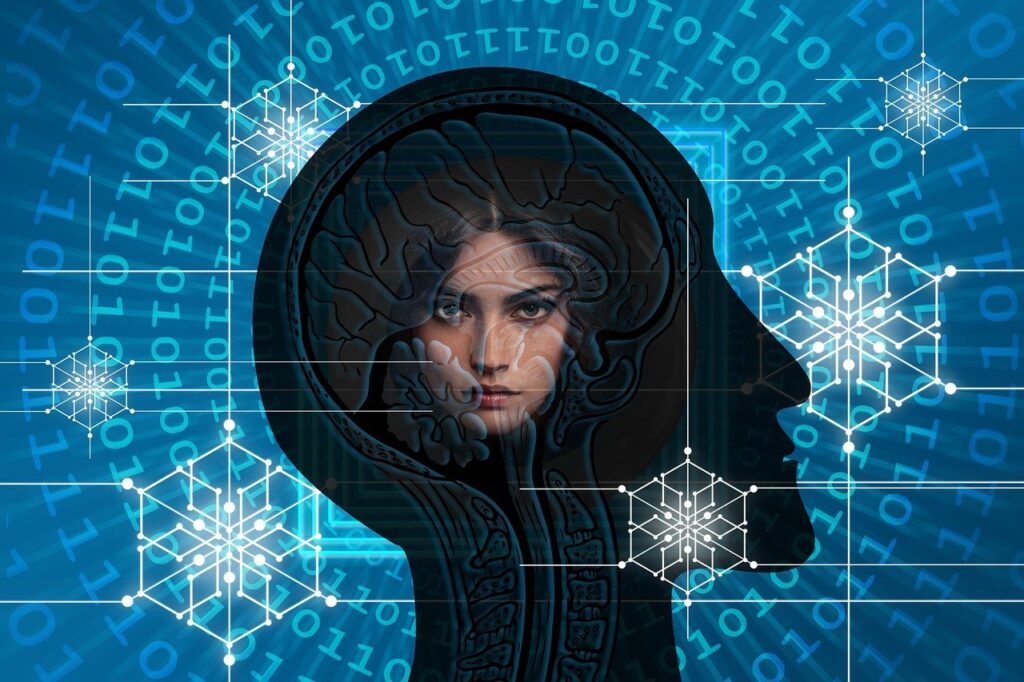
Artificial Intelligence (AI) is a branch of computer science focused on creating systems capable of performing tasks that typically require human intelligence. These tasks include reasoning, learning, problem-solving, understanding natural language, perception, and decision-making. AI systems achieve this through the development and application of algorithms and models that enable machines to process information, recognize patterns, and make decisions based on data.
Starting at age 44, your energy, metabolism, and overall well-being may be silently declining. Don’t wait for symptoms.
Introduction to Artificial Intelligence (AI):
Artificial Intelligence refers to the simulation of human intelligence processes by machines, especially computer systems. These processes include learning (the acquisition of information and rules for using the information), reasoning (using rules to reach approximate or definite conclusions), and self-correction. Specific applications of Artificial Intelligence include expert systems, speech recognition, and machine vision.
Origins and Evolution of Artificial Intelligence:
Early Beginnings:
The concept of artificial beings endowed with intelligence can be traced back to ancient myths and stories. However, the formal foundation of Artificial Intelligence as a scientific discipline began in the mid-20th century.
- 1950: Alan Turing, a British mathematician, introduced the idea of a machine that could simulate any conceivable act of mathematical deduction. This led to the development of the Turing Test, designed to evaluate a machine’s ability to exhibit intelligent behavior equivalent to or indistinguishable from that of a human.
- 1956: The term “Artificial Intelligence” was coined at the Dartmouth Conference by John McCarthy, Marvin Minsky, Nathaniel Rochester, and Claude Shannon. This event marked the official beginning of Artificial Intelligence research, with the goal of creating machines that could simulate any aspect of human intelligence.
The Initial Years (1950s-1970s):
In the early years, Artificial Intelligence research focused on symbolic methods and problem-solving techniques, laying the groundwork for future developments.
- 1950s-1960s: Researchers developed early AI programs like the Logic Theorist, which mimicked the problem-solving skills of a human, and the General Problem Solver, which was capable of solving a wide range of problems by breaking them down into subproblems.
- 1966: Joseph Weizenbaum created ELIZA, an early natural language processing program that could simulate a conversation with a human, demonstrating the potential for machines to understand and generate human language.
The AI Winter (1970s-1980s):
Despite initial progress, Artificial Intelligence faced significant challenges, including limited computational power and overly ambitious goals. These issues led to reduced funding and interest in AI, a period known as the “Artificial Intelligence Winter.”
- During this time, many AI projects failed to meet expectations, and skepticism grew about the feasibility of achieving true artificial intelligence. Funding agencies and investors became wary, leading to a slowdown in Artificial Intelligence research and development.
Resurgence and Modern AI (1990s-Present):
Advances in computational power, algorithm development, and data availability revitalized AI research, leading to significant breakthroughs and widespread applications.
- 1997: IBM’s Deep Blue defeated world chess champion Garry Kasparov, demonstrating the potential of Artificial Intelligence in strategic thinking and decision-making.
- 2011: IBM’s Watson won the game show Jeopardy!, showcasing advances in natural language processing, knowledge representation, and information retrieval.
- 2012: The deep learning revolution began, with neural networks developed by Geoffrey Hinton and his team achieving remarkable success in image recognition, leading to widespread adoption of deep learning techniques in various AI applications.
Key Applications of Artificial Intelligence:
AI’s applications span numerous fields, each with transformative potential. Here are detailed descriptions of Artificial Intelligence applications across various domains:
Healthcare:
AI has the potential to revolutionize healthcare by improving diagnostic accuracy, treatment effectiveness, and patient care.
- Medical Imaging: Artificial Intelligence algorithms analyze medical images, such as X-rays, MRIs, and CT scans, to detect abnormalities like tumors, fractures, and diseases with high precision. These tools assist radiologists in making more accurate and faster diagnoses.
- Predictive Analytics: AI models predict patient outcomes, disease progression, and treatment responses based on historical data and patient-specific information. This enables personalized medicine and proactive healthcare management.
- Drug Discovery: Artificial Intelligence accelerates drug discovery by identifying potential drug candidates, predicting their efficacy, and optimizing clinical trial designs. This reduces the time and cost associated with bringing new drugs to market.
- Virtual Health Assistants: AI-powered chatbots and virtual assistants provide medical advice, monitor patient health, schedule appointments, and remind patients to take their medications, improving patient engagement and adherence to treatment plans.
Finance:
Artificial Intelligence enhances the efficiency, accuracy, and security of financial services, transforming how businesses and consumers interact with financial systems.
- Fraud Detection: AI systems detect fraudulent activities by analyzing transaction patterns and identifying anomalies in real-time. These systems continuously learn from new data, improving their ability to identify and prevent fraud.
- Algorithmic Trading: Artificial Intelligence algorithms analyze market data and execute trades at optimal times, enhancing investment strategies and maximizing returns. These systems can process large volumes of data at high speeds, making split-second trading decisions.
- Credit Scoring: AI models assess credit risk by analyzing a wide range of data points, including non-traditional data such as social media activity and online behavior. This improves the accuracy of credit scoring and expands access to credit.
- Customer Service: Artificial Intelligence-powered chatbots handle customer inquiries, resolve issues, and provide personalized financial advice, enhancing customer satisfaction and reducing operational costs for financial institutions.
Transportation:
AI is transforming transportation by improving safety, efficiency, and convenience across various modes of transport.
- Autonomous Vehicles: Artificial Intelligence enables self-driving cars to navigate, recognize objects, and make real-time decisions, reducing accidents and traffic congestion. Autonomous vehicles use sensors, cameras, and AI algorithms to interpret their environment and operate safely.
- Traffic Management: Artificial Intelligence systems optimize traffic flow, reduce congestion, and improve public transportation efficiency by analyzing real-time data from various sources, including traffic cameras, sensors, and GPS devices.
- Predictive Maintenance: AI predicts maintenance needs for vehicles and infrastructure by analyzing data from sensors and diagnostic tools, reducing downtime and improving reliability. This proactive approach helps prevent failures and extend the lifespan of assets.
Manufacturing:
Artificial Intelligence optimizes production processes, quality control, and supply chain management, driving efficiency and innovation in manufacturing.
- Robotics: AI-powered robots perform complex tasks with precision and efficiency, improving productivity and reducing labor costs. These robots can adapt to changes in the production environment and work alongside human workers.
- Quality Control: Artificial Intelligence systems inspect products for defects using image recognition and machine learning, ensuring high-quality standards. These systems can detect minute defects that may be missed by human inspectors.
- Supply Chain Optimization: AI analyzes supply chain data to predict demand, manage inventory, and optimize logistics, reducing costs and improving delivery times. This leads to more efficient and responsive supply chain operations.
Retail:
Artificial Intelligence enhances the retail experience for both businesses and consumers by improving personalization, inventory management, and customer insights.
- Personalized Recommendations: AI algorithms analyze customer preferences and behavior to provide personalized product recommendations, increasing sales and customer satisfaction. These systems use collaborative filtering and content-based filtering techniques.
- Inventory Management: Artificial Intelligence predicts demand trends, optimizes stock levels, and reduces waste through accurate inventory forecasting. This helps retailers maintain optimal inventory levels and prevent stockouts or overstock situations.
- Customer Insights: AI analyzes customer feedback and sentiment to identify trends and improve customer satisfaction. This information helps retailers understand customer needs and preferences, enabling them to tailor their offerings and marketing strategies.
- Automated Checkout: Artificial Intelligence enables cashier-less stores where customers can shop and pay without manual checkouts, enhancing convenience and reducing wait times. These systems use computer vision and machine learning to track items and process payments automatically.
Education:
AI transforms education by personalizing learning experiences, improving administrative efficiency, and enhancing educational outcomes.
- Adaptive Learning: Artificial Intelligence systems provide personalized learning experiences by adjusting content and pace based on individual student needs and progress. These systems use data analytics to identify learning gaps and recommend targeted interventions.
- Tutoring Systems: AI-powered tutoring systems offer additional support to students, helping them understand complex subjects and improve their performance. These systems provide instant feedback and personalized guidance.
- Administrative Tasks: AI automates administrative tasks such as grading, scheduling, and student admissions, reducing the workload on educators and allowing them to focus on teaching and student engagement.
- Data Analytics: AI analyzes educational data to identify trends, improve curriculum design, and enhance teaching strategies. This data-driven approach helps educators make informed decisions and improve educational outcomes.
Entertainment:
AI enhances content creation, recommendation, and user experience in the entertainment industry, driving innovation and engagement.
- Content Recommendation: AI algorithms suggest personalized content (movies, music, books) based on user preferences and behavior, enhancing user satisfaction and engagement. These systems use collaborative filtering, content-based filtering, and hybrid approaches.
- Game Development: AI creates realistic and adaptive game environments, enhancing player experience through intelligent non-player characters (NPCs) and procedural content generation. These systems can generate dynamic and immersive game worlds.
- Virtual Reality (VR) and Augmented Reality (AR): AI powers immersive VR and AR experiences, enabling realistic interactions and environments. These systems use computer vision, natural language processing, and other AI techniques to create engaging and interactive experiences.
- Content Creation: AI assists in creating music, art, and writing by generating creative ideas and completing tasks based on input data. These systems can produce high-quality content that is indistinguishable from human-created works.
Security:
AI strengthens security measures by enhancing threat detection, response, and prevention across various domains.
- Cybersecurity: AI detects and mitigates cyber threats by analyzing network traffic, identifying vulnerabilities, and responding to attacks in real-time. These systems use machine learning to adapt to new threats and improve their effectiveness.
- Surveillance: AI-powered surveillance systems recognize faces, detect unusual activities, and alert authorities, improving public safety. These systems use facial recognition, object detection, and other AI techniques to monitor and analyze video footage.
- Fraud Prevention: AI identifies fraudulent activities in various sectors, including banking, insurance, and e-commerce, reducing financial losses. These systems analyze transaction patterns and detect anomalies that may indicate fraud.
- Biometric Authentication: AI enhances security through biometric authentication methods such as facial recognition, fingerprint scanning, and voice recognition. These systems provide a higher level of security compared to traditional authentication methods.
Artificial Intelligence has made significant strides since its inception, evolving from theoretical concepts to practical applications that impact nearly every aspect of our lives. Its transformative potential continues to grow as advancements in technology and research push the boundaries of what is possible. From healthcare and finance to transportation and entertainment, AI is reshaping industries, improving efficiency, and enhancing the quality of life. As we move forward, ethical considerations and responsible AI development will be crucial to ensuring that AI benefits all of humanity.
AI, Capabilities and Limitations
What Artificial Intelligence (AI) Is:
Artificial Intelligence is a field of computer science dedicated to creating systems capable of performing tasks that typically require human intelligence. These tasks include:
Learning:
Machine Learning: AI systems can learn from data using algorithms that identify patterns and make decisions based on the information provided. This involves training models on large datasets to recognize correlations and predict outcomes.
Reasoning:
Decision-Making: AI can process vast amounts of data to make decisions or solve problems. This is often achieved through algorithms that simulate human decision-making processes.
Perception:
Computer Vision: AI systems can interpret visual information from the world, such as recognizing objects, faces, and scenes in images and videos.
Speech Recognition: AI can understand and transcribe spoken language, enabling applications like virtual assistants and automated transcription services.
Natural Language Processing (NLP):
Language Understanding: AI can comprehend and generate human language, facilitating applications such as chatbots, translation services, and sentiment analysis.
Problem-Solving:
Optimization and Planning: AI can find optimal solutions to complex problems and plan actions to achieve specific goals. This is used in logistics, robotics, and strategic game playing.
What Artificial Intelligence Is Not:
Not Truly Conscious:
AI does not possess consciousness, self-awareness, or subjective experiences. It cannot feel emotions or have personal insights; it operates purely based on data and programmed instructions.
Not Infallible:
AI systems are not infallible and can make errors, especially if they are trained on biased or incomplete data. Their accuracy and reliability depend heavily on the quality of the data and algorithms used.
Not a Replacement for Human Judgment:
AI is a tool to augment human capabilities, not replace human judgment entirely. Complex decision-making, ethical considerations, and understanding nuanced contexts often require human intervention.
Not Universally Applicable:
AI is not a one-size-fits-all solution. Its effectiveness varies across different domains and specific tasks. Some problems are better suited to AI solutions than others.
What AI Can Do:
Data Analysis:
AI excels at analyzing large datasets to uncover patterns, trends, and insights that would be difficult or impossible for humans to detect.
Automation:
AI can automate repetitive and mundane tasks, increasing efficiency and freeing up human workers to focus on more complex and creative tasks.
Enhance User Experience:
AI can personalize user experiences by recommending products, content, or services based on individual preferences and behaviors.
Improve Accuracy:
In fields like medical diagnosis, AI can assist doctors by providing highly accurate analyses of medical images and predicting patient outcomes.
Predictive Maintenance:
AI can predict when machines or systems are likely to fail, enabling proactive maintenance and reducing downtime in industries like manufacturing and transportation.
What AI Cannot Do:
Generalize Beyond Training:
AI models typically cannot generalize well beyond the specific tasks they were trained for. They may struggle with novel situations that deviate significantly from their training data.
Understand Context Like Humans:
AI often lacks the deep contextual understanding that humans possess, which can lead to misunderstandings or incorrect interpretations of data or situations.
Creativity and Innovation:
While AI can generate new ideas by combining existing data in novel ways, true creativity and innovation, which involve intuition and emotional insight, remain beyond its reach.
Ethical Decision-Making:
AI lacks the inherent understanding of ethics and morals that humans have. It can follow ethical guidelines programmed into it but cannot inherently discern right from wrong.
Empathy and Emotional Intelligence:
AI cannot genuinely empathize with humans or understand emotional nuances. It can recognize and respond to emotional cues but without true emotional comprehension.
AI represents a significant advancement in technology, offering powerful tools for data analysis, automation, and enhancement of various tasks. It can perform many functions that streamline operations, provide insights, and augment human capabilities. However, AI is not a replacement for human intelligence, judgment, or creativity. Its current limitations include a lack of consciousness, contextual understanding, and ethical discernment, underscoring the need for human oversight and intervention. As AI continues to evolve, it is crucial to harness its strengths while acknowledging and addressing its limitations to ensure it serves as a beneficial tool for society.
Discover More of Technology Splendor: Explore Our Other Sites
Your Health is your Best Investment
Energy, clarity, and balance are the foundation of every dream. Without health, wealth loses its shine and relationships lose their spark. Discover strategies to strengthen your body, sharpen your mind, and energize your spirit.
Learn How to Protect It →Relationships Give Life Meaning
Health gives you energy. Wealth gives you freedom. But only deep, authentic relationships give life true purpose. Discover the tools to connect, love, and communicate at your best.
Improve your Personal and Business Relationships
